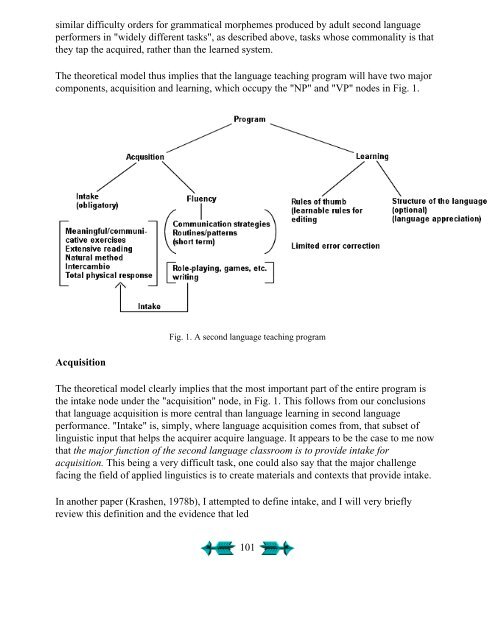Second Language Acquisition and Second ... - Stephen Krashen
Second Language Acquisition and Second ... - Stephen Krashen
Second Language Acquisition and Second ... - Stephen Krashen
You also want an ePaper? Increase the reach of your titles
YUMPU automatically turns print PDFs into web optimized ePapers that Google loves.
similar difficulty orders for grammatical morphemes produced by adult second language<br />
performers in "widely different tasks", as described above, tasks whose commonality is that<br />
they tap the acquired, rather than the learned system.<br />
The theoretical model thus implies that the language teaching program will have two major<br />
components, acquisition <strong>and</strong> learning, which occupy the "NP" <strong>and</strong> "VP" nodes in Fig. 1.<br />
<strong>Acquisition</strong><br />
Fig. 1. A second language teaching program<br />
The theoretical model clearly implies that the most important part of the entire program is<br />
the intake node under the "acquisition" node, in Fig. 1. This follows from our conclusions<br />
that language acquisition is more central than language learning in second language<br />
performance. "Intake" is, simply, where language acquisition comes from, that subset of<br />
linguistic input that helps the acquirer acquire language. It appears to be the case to me now<br />
that the major function of the second language classroom is to provide intake for<br />
acquisition. This being a very difficult task, one could also say that the major challenge<br />
facing the field of applied linguistics is to create materials <strong>and</strong> contexts that provide intake.<br />
In another paper (<strong>Krashen</strong>, 1978b), I attempted to define intake, <strong>and</strong> I will very briefly<br />
review this definition <strong>and</strong> the evidence that led<br />
101











